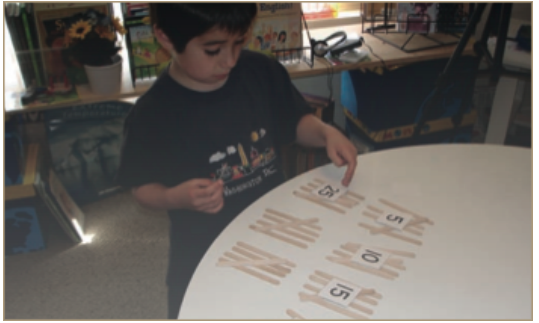I am writing this from the perspective of a math specialist in the United states. Cultural and linguistic differences will influence specific struggles in any given country. One example is on the counting system and writing numbers. In English, children often struggle with numbers 13-19, often writing them 31, 41, etc because of the mismatch between the way it sounds and the way we write them. However, in Japan, the numbers are literally 10-3, 10-4, etc., so writing 13-19 is not an issues like in English.
When reflecting the most common reasons why children struggle in mathematics, the biggest reasons that come to mind are the following:
- Working the weaker side of the brain
- Not making connections between the concrete – abstract
- Children being taught in a developmental level beyond where they actually are
- Lack of true understanding of base ten
Working the weaker side of the brain
When I worked as a math resource specialist, pulling out children, I noticed that there were two types of students, one who were simply missing some math concepts along the way, mostly because of their frequent moves due to military life, which was easily remedied, and those who were right brain learners trying to function and learn in a subject predominantly taught in a left-brain way, which was much harder to rehabilitate.
There are areas in the left hemisphere where counting sequence and computation abilities are stored, but the right hemisphere is responsible for the pictorial representations and connecting the math to real life situations. Children who are left-brain dominant, can make sense of math simply through the manipulation of numbers, but may never truly understand their representations.
This was my experience. I excelled in math all through high school. It was when I was in my math specialist program for teachers when I understood by day 3 that I really didn’t understand math at all. I spent my entire life being able to manipulate numbers and solve problems with formulas, but had no idea that those formulas could be found in models. So now when I work with children on constructing representation with manipulatives, I constantly am asking, “where is this number in the model?”
On the flip side, children who are predominantly right brain thinkers may struggle deeply with being able to access those left-brain skills, such as sequencing and computation and may even experience dyscalculia, a type of dyslexia but with numbers and calculation. However, they may be able to see relationships between numbers, easily find patterns, and solve problems through drawing a pictorial representation or making a model.
It is imperative that these children are allowed to somehow build or draw a representation of the problem before being able to understand how the numbers and computational strategies fit in. If these children are forced to memorize procedures without a visual and mental representation upon which to attach these memorized procedures, they will not be able to be flexible in their thinking and will often make gross mistakes on not realize that their answers do not make sense.
This is the problem with the way the math pendulum swings in the US. We tend to either focus heavily on computation (left-brain) or visual representations and understanding (right), but few teachers with deep understanding of mathematics will provide a strategic balanced approach.
Not making connections between the concrete – abstract
There are 5 ways to represent math: symbols, real-life situation, pictorial (drawing), manipulatives, and written and spoken language. The level of mathematical power an individual student has is related to the strength of the connections they have between these representations.
These 5 representations vary in level of abstractness and teachers have a tendency to be teaching through symbols and might throw in some real-life situations at the end. So our curriculum tends to lead with numbers and end with situations. In the last 15 years there has been a push in the common core to make connections between all 5 representations, but simply mandating it in the standards does not ensure that teachers really understand what that means and how to successfully teach it.
While I was a resource specialist, I started learning about brain development and realized that the reason that the model of 5 representations worked was because they were located in different parts of the brain, some in the left hemisphere and some in the right. So, when a student had strong connections between them, they essentially had strengthened the connections between the hemispheres.
I once had a classroom situation where I was teaching both 4th and 5th grade. During math, my 4th graders went to a different class and I kept the 5th graders. I also received some students from the gifted class. These were 5 girls who were very strong with numbers and computation, but initially resisted my requests to draw or build a model of a specific problem. It was through these models that we were able to explore more deeply different computational strategies and understand why they worked. Once the started doing this and made the connections to the numbers, which were already easy for them to manipulate, they became very powerful mathematical thinkers.
When I was teaching at the university, a group of professors had outlined in studies that as a whole, the most effective strategy for teaching all children was to move through a strategic sequence of concrete to abstract representations. For example, a unit on teaching addition with regrouping might have a couple of days just modeling real-world problems, then a couple of days of creating a pictorial representation of what they did with their model, and then connect it to numbers and a numerical representation and computation strategy that could now make sense because it was generated from a more concrete experience.
This is not only good for young children, but older students learning higher math concepts as well. Every time a new and more complicated concept is introduced, students of all ages will have the ability to solve it if given the opportunity to either act it out, build a model, or draw a picture. Once they can make sense of what is happening, then they can begin to attach numbers and symbols. The book I co-authored, “Elementary Math is Anything but Elementary” shows how to do exactly this for every subject from k-6. I have also engaged in learning experiences using this concept for algebra and statistics. I was also going to take a calculus course for teachers with these principles (so I could finally understand what that was all about from my high school days), but the class was cancelled due to lack of interest.
Children not being taught at their developmental level
There are 6 identified phases of mathematics that students pass through, and must pass through. What often happens is that for whatever reason, students do not fully develop at one phase and when they move to the next grade the curriculum might be at a higher phase than where the child is actually working. So, in order to compensate, the child may just memorize procedures but with zero understanding of underlying concepts.
It is important that teachers are familiar with these phases, which can be found in my book “A Quantitative and Qualitative Developmental Assessment and Intervention Protocol,” and know what kinds of experiences children need in order to pass through to the next phase.
A simple thing that teachers can do is to reduce the number size when teaching a concept that is too hard. Reducing the number size gives children access to difficult concepts. Allowing the child to build the problem will also be very important in allowing access to harder concepts.
A lack of deep understanding of base 10
In the US, it is common that children who are not working at their developmental level will fall apart once they are trying to learn long division. The steps in our standard algorithm just do not make any sense and there are too many steps for them to hold on to if they are really functioning in a lower phase.
I find that it is all rooted into a lack of understanding of base 10, and it is possible that one of the reasons children in the US struggle with base 10 is due to our counting system that I described earlier. Lipping Ma, a US mathematics researcher from China has written about the differences between the place value understanding between the two cultures based on the way we count, or label our numbers.
Summary
Above I described some of the overarching reasons why children in the US struggle with math concepts. I have not addressed specific content areas within mathematics, because although there are uniquenesses within each subset of math (like fractions, decimals, multiplication, etc.), if taught with the above principles in mind, all areas can be made accessible to students of any age. For example, when I was a math coach at an elementary school in California, I remember once going to a first grade class who were solving problems such as of 1/3 of 15 by using counters and drawing pictures. The problems were presented orally and the students made representations of the problems and were very successful. I then passed to a 5th grade class who was teaching the same thing, but just with the symbolic notation 1/3 x 15 and most struggled. I took copies of the students work and presented them at a professional development meeting to make a point that any given concept can be solved at any age if made comprehensible and if allowed to represent it in ways that were at the child’s developmental level.
My books for teaching math from a developmental perspective can be found here.





0 Comments